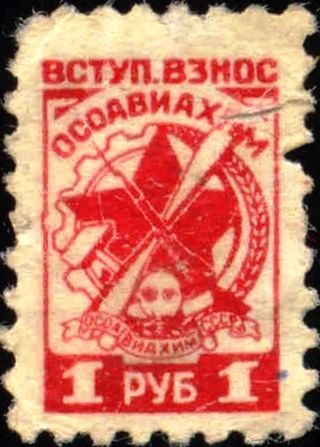PJSC Aeroflot – Russian Airlines, commonly known as Aeroflot, is the flag carrier and the largest airline of Russia. Aeroflot is headquartered in the Central Administrative Okrug, Moscow, with its hub being Sheremetyevo International Airport. The Federal Agency for State Property Management, an agency of the Government of Russia, owns 73.77% of the company, with the rest of the shares being public float.

The Ilyushin Il-86 is a short- to medium-range wide-body jet airliner that served as the USSR's first wide-bodied aircraft. Designed and tested by the Ilyushin design bureau in the 1970s, it was certified by the Soviet aircraft industry, manufactured and marketed by the USSR.

The Society for the Assistance of Defense, Aircraft and Chemical Construction was a Soviet socio-political defense organization and mass voluntary society that existed from 1927–1948. It was the predecessor of DOSAAF.

Dobrolyot, or sometimes Dobrolet, was an early Soviet airline, with the name drawn from part of its full name. The Russian Society of Voluntary Air Fleet was formed in 1923 and existed throughout the remainder of the 1920s. It was formed in imitation of the Russian Merchant Navy Volunteer Fleet (Dobroflot), which had previously been formed back in 1878.
This is a glossary of acronyms and initials used for organisations in the Russian Federation and formerly the USSR. The Latin-alphabet names are phonetic representations of the Cyrillic originals, and variations are inevitable.
Aviation has been a part of Moldovan society since the early 20th century.

Transport in the Union of Soviet Socialist Republics (USSR) was an important part of the nation's economy. The economic centralisation of the late 1920s and 1930s led to the development of infrastructure at a massive scale and rapid pace. Before the Soviet Union's collapse in 1991, there were a wide variety of modes of transport by land, water and air. However, because of government policies before, during and after the Era of Stagnation, investments in transport were low. By the late 1970s and early 1980s Soviet economists were calling for the construction of more roads to alleviate some of the strain from the railways and to improve the state budget. The civil aviation industry, represented by Aeroflot, was the largest in the world, but inefficiencies plagued it until the USSR's collapse. The road network remained underdeveloped, and dirt roads were common outside major cities. At the same time, the attendance of the few roads they had were ill-equipped to handle this growing problem. By the late-1980s, after the death of Leonid Brezhnev, his successors tried, without success, to solve these problems. At the same time, the automobile industry was growing at a faster rate than the construction of new roads. By the mid-1970s, only 0.8 percent of the Soviet population owned a car.

The 1971 January 22 Surgut Aeroflot Antonov An-12 crash occurred on 22 January 1971, when an Aeroflot Antonov An-12B, registered CCCP-11000, flying from Omsk Tsentralny Airport, in the Soviet Union's (RSFSR), crashed 15 km (9.3 mi) short of the runway on approach to Surgut International Airport, Surgut, RSFSR. An investigation found the aircraft's ice protection system was ineffective because the engine bleed air valves were closed during the flight; ice therefore built up on the aircraft causing it to go out of control.

Ilya Pavlovich Mazuruk was a Soviet pilot and polar explorer. Hero of the Soviet Union (1937).

The 31 January 1971 Surgut Aeroflot Antonov An-12 crash occurred on 31 January 1971, when an Aeroflot Antonov An-12B, aircraft registration CCCP-12996, flying from Roshchino International Airport, Tyumen, in the Soviet Union's Russian Soviet Federated Socialist Republic (RSFSR), crashed 13.6 km (8.5 mi) short of the runway on approach to Surgut International Airport, Surgut, RSFSR. An investigation found the aircraft's loss of control was caused by icing.
The Riga Civil Aviation Engineers Institute (RCAEI) (Latvian: Rīgas Civilās Aviācijas Inženieru Institūts (RCAII), Russian: Рижский институт инженеров гражданской авиации (РКИИГА until 1991), Рижский авиационный университет (РАУ until 1999)) was an engineering university in the USSR and Latvia. It was founded in 1919 and closed in 1999. Thousands of students graduated from the institute from over 93 countries. The institute had several different names during its history as well as moving from Kiev to Moscow to Petrograd to Riga. Riga Aviation University closed in 1999, with its programmes moved to Riga Technical University.

Aeroflot Flight 207 was a Soviet domestic passenger flight from Rostov-on-Don Airport to Tbilisi International Airport that crashed on 10 June 1960 in the Tkvarcheli district. The crash involved an Ilyushin Il-14 aircraft operated by Aeroflot. There were 24 passengers and 7 crew on board, all of whom perished in the crash.

Aeroflot Flight 120 was an international Soviet passenger flight from Kabul International Airport in Afghanistan to Tashkent International Airport in the Uzbek SSR. On 13 December 1959 the Aeroflot Ilyushin Il-14P operating the flight crashed in the Boysun District killing all 25 passengers and 5 crew on board.

Aeroflot Flight 213 was a regularly scheduled passenger flight operated by Aeroflot from Chersky Airport to Keperveyem Airport. On 18 September 1962, the Ilyushin Il-14 operating this flight crashed shortly after takeoff. All 27 passengers and five crew members were killed.
Civil defense in Russia is the system of measures to protect people and material assets in the Russian Federation in the event of hostilities, natural disasters or technological disasters, as well as the preparation of such measures. These measures include sheltering, evacuation, disguising facilities, first aid and basic residents.

Aeroflot Flight 19 was a scheduled passenger flight from Bykovo Airport, Moscow, to Bryansk Airport, Bryansk. On 2 November 1973, a Yak-40 aircraft operating the flight was hijacked by 4 people 10 minutes before landing. The aircraft was then diverted to Moscow's Vnukovo Airport, where the hijackers demanded a buyout and provision of a flight to Sweden. The hostages inside the aircraft were subsequently liberated after the authorities stormed the aeroplane. This is one of the first well-known cases of storming a hijacked aircraft on the territory of the USSR.

Ural Works of Civil Aviation is an aircraft manufacturing and aircraft repair enterprise, one of the major manufacturers in the aircraft manufacturing industry in Russia. It specializes in the development, production, testing, repair and maintenance of aircraft equipment, components and assemblies. The company includes a production center for engine maintenance and repair, aircraft manufacturing facilities, an engineering center, and a number of subsidiaries, affiliates, and separate companies.

Aeroflot Flight 10 was an aviation disaster involving an Ilyushin Il-12 aircraft operated by Aeroflot, which occurred on Wednesday, 18 December 1957 30 kilometers west of Birobidzhan, resulting in the deaths of 27 people.

Aeroflot Flight 136 was an aviation disaster involving an Ilyushin Il-12P passenger aircraft operated by Aeroflot, which occurred on Thursday, October 28, 1954, in Krasnoyarsk Krai on the slope of Mount Sivukha. The crash resulted in the deaths of 19 people.

The Aeroflot Flight 105 was an aviation accident involving an Il-12P aircraft operated by Aeroflot, which occurred on Monday, June 9, 1958 near Magadan, resulting in the deaths of 24 people.











